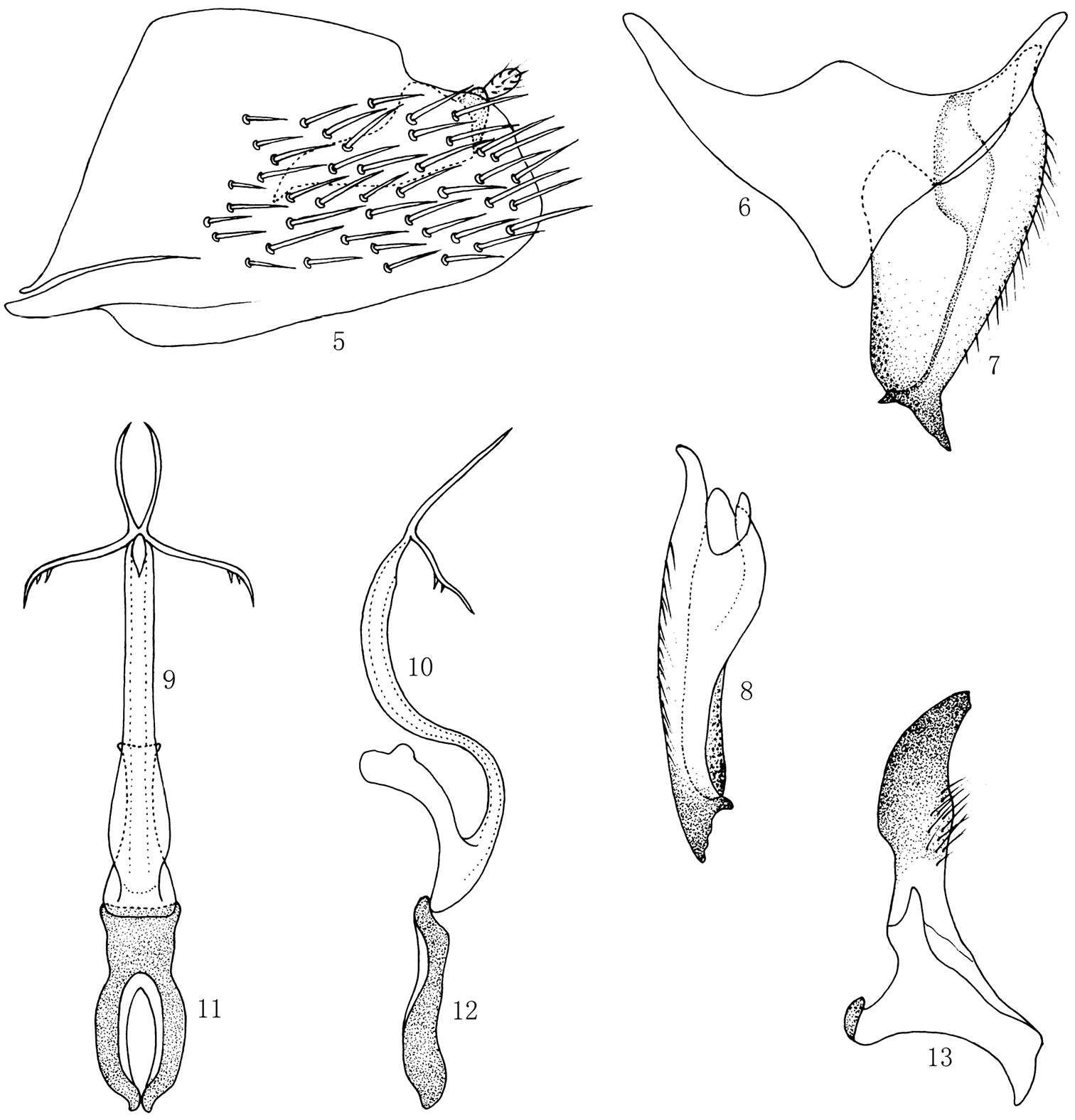






(C) 2014 Ji-Chun Xing. This is an open access article distributed under the terms of the Creative Commons Attribution License (CC BY 4.0), which permits unrestricted use, distribution, and reproduction in any medium, provided the original author and source are credited.
For reference, use of the paginated PDF or printed version of this article is recommended.
Citation: Xing JC, Li ZZ (2014) The leafhopper genus Multiproductus Xing, Dai & Li in China (Hemiptera, Cicadellidae, Deltocephalinae, Paralimnini), with description of one new species. ZooKeys 369: 43–48. doi: 10.3897/zookeys.369.6614
General characteristics of Multiproductus and a new species Multiproductus complantus sp. n. are described and illustrated. A key is given to distinguish all species of the genus.
Homoptera, morphology, taxonomy, distribution
The Oriental leafhopper genus Multiproductus belonging to Paralimnini of Deltocephalinae (Hemiptera: Cicadellidae), was established by
Specimens were collected by sweeping net. Dry specimens were used for the description and illustration. External morphology was observed under a stereoscopic microscope and characters were measured with an ocular micrometer. The genital segments of the examined specimens were macerated in 10% NaOH and drawn from preparations in glycerin jelly using a Leica MZ 12.5 stereomicroscope. Illustrations were scanned with Canon CanoScan LiDE 200 and imported into Adobe Photoshop CS3 for labeling and plate composition.
Terminology of morphological and genital characters follow
http://species-id.net/wiki/Multiproductus
Multiproductus ramosus Xing, Dai & Li, 2011.
For the relationship and diagnosis of Multiproductus Xing, Dai & Li, 2011 see
China (Guizhou, Yunnan, Hainan).
| 1 | Aedeagal shaft with three pairs of lateral preapical processes; apical process of style narrow, tubular shape (see |
Multiproductus ramosus |
| – | Aedeagal shaft with two pairs of lateral preapical processes; apical process of style wide and flat, sword shape (Figs 9, 10, 13) | Multiproductus complantus sp. n. |
http://species-id.net/wiki/Multiproductus_ramosus
China: 1♂ (Holotype), Guizhou Prov., Guanling County, Huajiang, 16 August 2009, coll. Jichun Xing; 2♂♂4♀♀, Guizhou Prov., Guanling County, Huajiang, 16 August 2009, coll. Jichun Xing; 1♂, Guizhou Prov., Ziyun County, Baishiyan, 28 July 2008, coll. Jichun Xing; 1♀, Guizhou Prov., Yanhe County, Mayanghe, 10 June 2007, coll. Jichun Xing; 1♀, Yunnan Prov., Menghai County, Mannong, 24 July 2008, coll. Yuehua Song; 1♂, Yunnan Prov., Baoshan City, Baihualing, 7 May 2010, coll. Yanli Zheng; 1♂1♀, Hainan Prov., Bawangling, 16 April 2013, coll. Jichun Xing.
China (Guizhou, Yunnan, Hainan).
http://zoobank.org/28A036CA-70C0-48B7-8410-D0D405913F75
http://species-id.net/wiki/Multiproductus_complantus
Figs 1–13Yellowish-brown species, with light veins on forewings. Crown yellowish brown with four dark brown marks on anterior margin and orange–yellow longitudinal band midway between midline and eye extending to posterior margin of pronotum. Eyes black, fairly large. Ocelli pale yellow. Face black, frontoclypeus with yellowish brown transverse stripes on both sides. Forewings pale yellow. Hind macropterous. Legs marked with brown.
Head slightly wider than greatest width of pronotum. Vertex with fore margin produced triangularly, median length longer than width between eyes. Ocelli on anterior margin, separated from corresponding eye by approximately their own diameter. Frontoclypeus distinctly longer than wide, anteclypeus slightly narrowed apically. Antennae arising near lower corner of eye. Pronotum with anterior margin strongly and roundly produced, posterior margin slightly concave. Scutellum triangular, slightly shorter than pronotum, with transverse suture curved and depressed. Forewing with outer subapical cell extended to costal margin, branches of vein R recurved distally, resulting in fifth (outer) apical cell, and veins of clavus appear to extend to the claval suture, 4 times as long as wide, appendix present. Hind wings with three apical cells and two anteapical cells. Profemur with 2 dorsoapical setae. Hind femur apical setal formula 2+2+1. Hind tibia flattened and nearly straight, with PD setae very long, several supernumeral setae present between AD and AV rows; AD row with somewhat thin setae between very thick macrosetae. Metabasitarsomere with three platellae and two setae on apical transverse row; plantar surface with one row of five stout setae at middle and one row of four stout setae at lateral margin.
Male genitalia. Male pygofer side elongate with many large setae medially; without processes (Fig. 5). Valve subtriangular with anterior margin produced and posterior margin strongly produced medially (Fig. 6). Subgenital plate wide, with uniseriate row of macrosetae along lateral margin, internal appendage short and mucronate (Figs 7, 8). Aedeagal shaft elongate and sinuate; with two pairs of lateral preapical processes, proximal pair with two small spines; gonopore subapical on ventral surface (Figs 9, 10). Connective loop–shaped with arms fused apically; stem present, articulated with the aedeagus (Figs 11, 12). Apical process of style wide and flat, sword shape (Fig. 13).
Multiproductus complantus sp. n. 1 ♂, dorsal view 2 ♂, lateral view 3 Head and thorax, dorsal view 4 ♂, face.
Multiproductus complantus sp. n. 5 Male pygofer side, lateral view 6 Valve, ventral view 7 Subgenital plate, ventral view 8 Subgenital plate, lateral view 9 Aedeagus, ventral view 10 Aedeagus, lateral view 11 Connective, ventral view 12 Connective, lateral view 13 Style, dorsal view.
Length (including tegmen): ♂, 3.0 mm.
Grasses.
Holotype ♂, China: Guizhou Prov., Ziyun County, Baishiyan, Kazha, 2 October 2013, coll. Jichun Xing (GUGC).
This new species is similar to Multiproductus ramosus Xing, Dai & Li, 2011 in appearance, but can be distinguished from the latter by the aedeagal shaft with two pairs of lateral preapical processes, the apical process of style wide and flat, sword shape, and the valve subtriangular and subgenital plate wide.
The species name is derived from the Latin word “complantus”, referring to the apical process of style wide and flat.
We are grateful to two anonymous referees for reading the manuscript and making some suggestions. This work was supported by China Postdoctoral Science Foundation funded project (2013T60864, 2012M521719) and the National Natural Science Foundation of China (31301909).

